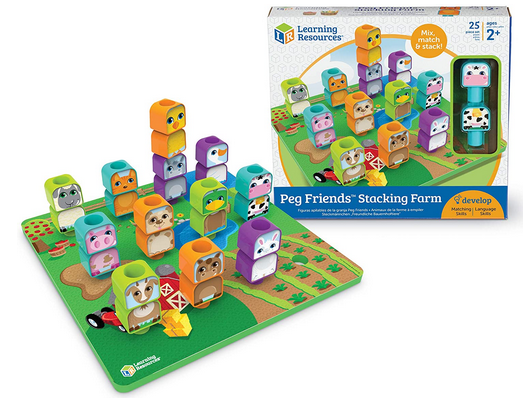 |
| Peg Friends Stacking Farm |
Peg Friends Stacking Farm is an updated version of an old-fashioned pegboard activity. I previously blogged about Peg People Around the Town, which includes a mat with a town scene and 9 3-piece peg community helper persons. Peg Friends Stacking Farm has a mat with a simple farm scene and 12 2-piece farm animals.
The mat base is made of firm foam with a farm picture (see image above). The mat is a 10" square. There are 12 holes in the mat, one for each animal.
The animals are each made of two plastic pegs - top and bottom. Each animal will be 3.25" when stacked. Each animal will have the same color pegs, top and bottom. There are three animals with blue pegs, three with purple pegs, three with green and three with orange. Each peg has a hole on top so that you can stack them as high as you want. The animals are stickers. I have used my other version quite a bit and no sticker shows any signs of coming off. Learning Resources is one of my favorite toy makers, in part because of the durability of their products.
The mats and pegs are the same size so you can use them together if you have both.
One of my pet peeves with games is when they put a hole in the box so the contents can show through. This requires you to keep the inside packaging intact so the pieces don't fall out or else bag them. This has a box like that.
- Play with the pieces and show how they stack and then insert into the mat.
- Sort the pegs into piles by color, them build the animals.
- Place all the animal bottoms on the board and let the player place the correct head on each one.
- Place the two pieces for an animal next to the individual and ask them to assemble in the correct order.
- Put two pieces together that don't match and then make up a name for your new animal. A pig and a donkey might be a pinkey or ponkey.
- Talk about each animal as you play. Break into a verse of Old McDonald's Farm.
- Sing the Old McDonald's Farm chorus making the sounds of the animals in the order they are stacked on the mat. With a moo moo here, and a meow meow there, and a quack quack here, and an oink oink there...
- Mix the pieces together. Call out an animal. Let the player find the two pieces, assemble them and place the on the farm mat. Or instead of calling out an animal, make an animal sound.
- Use two hands. Hold the bottom piece in one hand and place the other piece on top. Then put the animal into the mat.
- Stack all the pegs in one big tower. Reach up as high as you can. I steady it as they go.
- Work
on visual discrimination, spatial relations, eye-hand coordination,
coordinated use of two hands, body awareness, sequencing,
manual dexterity, process skills, creativity, executive functioning
skills, play and leisure exploration and participation



